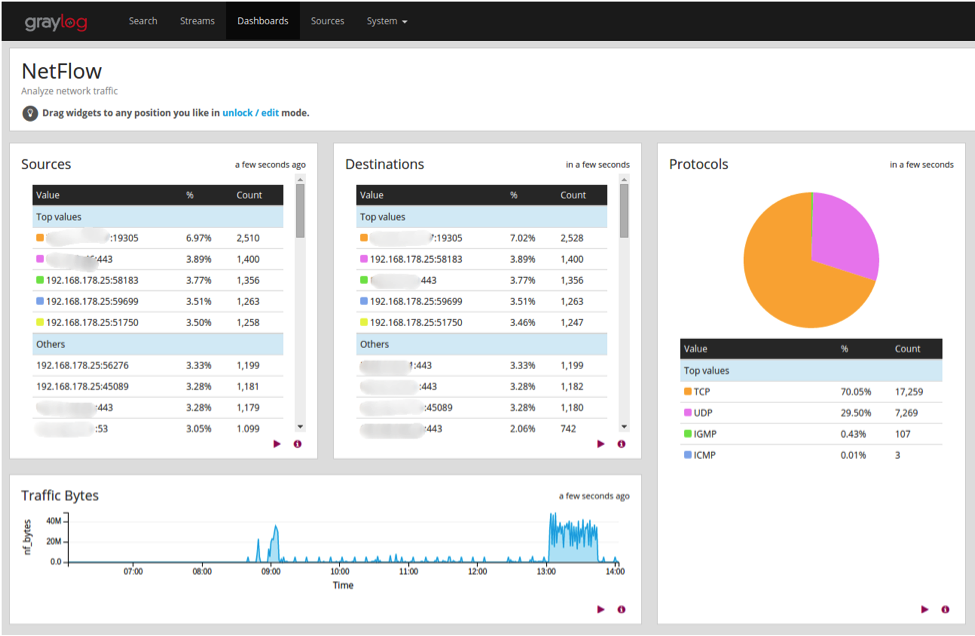

With this option you can modify this behaviour by # responses and don't resolve numeric IPs 3 - Don't decode DNS responses and don't resolve # (-m) numeric IPs 1 - Decode DNS responses and resolve all numeric IPs 2 - Decode DNS # Sets the DNS address resolution mode: 0 - Decode DNS responses and resolve only local Both netmask and CIDR notation may be used, # Commas separate multiple network values. If not specified the default is set to 192.168.1.0/24. # networks and subnetworks whose traffic is also considered local in ntopng reports. This parameter allows the user to define additional # ntopng determines the ip addresses and netmasks for each active interface. # Sets the HTTP port of the embedded web server. # Note that you can specify -i multiple times in order to instruct ntopng to create multi.

Ntopng raspberry windows#
On Windows you must use the interface number instead. On Unix you can specify both the interface name (e.g. # Specifies the network interface or collector endpoint to be used by ntopng for network # controlled with systemd (e.g., service ntopng start) # tool, you probably will want to use this option. To use ntop other than as a casual monitoring # without connection to a specific terminal.

# This parameter causes ntop to become a daemon, i.e. # ntopng is controlled with systemd (e.g., service ntopng start). # Specifies the path where the PID (process ID) is saved. # sign '=' must be used between key and value. # The configuration file is similar to the command line, with the exception that an equal # ntopng-1.0_1234.x86_64.rpm Starting ntopngĬreate /etc/ntopng/nf, setting the interface to match the actual name of the network interface and dump-flows to match the MySQL database and userid you set up. +NLIBS = $(DLK_LIBS) $(NDPI_LIB) $(LIBPCAP) $(LUA_LIB) $(LIBRRDTOOL_LIB) $(ZEROMQ_LIB) $(JSON_LIB) $(SNMP_LIB) $(SODIUM_LIB) $(ZSTD_LIB) -lm -lpthreadĬPPFLAGS = $(MONGOOSE_INC) $(JSON_INC) $(SNMP_INC) $(SODIUM_INC) $(NDPI_INC) $(LUA_INC) $(LIBRRDTOOL_INC) $(ZEROMQ_INC) -I$(HTTPCLIENT_INC) -DDATA_DIR='"$(datadir)"' -I$/third-party/patricia # -D_GLIBCXX_DEBUG NLIBS = $(NDPI_LIB) $(LIBPCAP) $(LUA_LIB) $(LIBRRDTOOL_LIB) $(ZEROMQ_LIB) $(JSON_LIB) $(SNMP_LIB) $(SODIUM_LIB) $(ZSTD_LIB) -lm -lpthread I modified the Makefile.in file as follows to include them: There were libraries missing from the linking step in the compile process for ntopng. I had to modify Makefile.in before compiling ntopng, see below
Ntopng raspberry install#
$ sudo make install Compiling ntopng $ cd. Run sudo geoipupdate command to install the GeoIP database files.Ĭompile and install the nDPI and ntopng packages from /ntop Prepare the development environment $ sudo apt install autoconf libtool libjson-c-dev libpcap-dev libgcrypt20-dev autogen autogen-doc bison flex guile-2.0-libs libbison-dev libfl-dev libgc1c2 libnuma-dev libopts25 libopts25-dev libpcre2-32-0 libpcre2-dev libtool-bin libssl-dev librrd-dev libcurl4-openssl-dev libmaxminddb-dev libsqlite3-dev libxml2-dev rrdtool libhiredis-dev libpango1.0-dev libcairo2-dev libnetfilter-queue-dev libcap-dev libnetfilter-conntrack-dev libreadline-dev libldap2-dev rename libsnmp-dev libzmq3-dev default-libmysqlclient-dev Compiling nDPI $ cd ~/src Run sudo mkdir /usr/share/GeoIP to create the target directory. # The directory to store the database files. # `EditionIDs` is from your MaxMind account.ĮditionIDs GeoLite2-ASN GeoLite2-City GeoLite2-Country # `LicenseKey` is from your MaxMind account. # `AccountID` is from your MaxMind account. # For more information about this config file, visit the docs at # nf file for `geoipupdate` program, for versions >= 3.1.1. Ĭreate an account at MaxMind, register for an API key, and edit /usr/local/etc/nf as follows: Install the geoipupdate armv6 binary from the Maxmind releases page on github. * TO OK, 0 rows affected (0.00 sec) Install GeoIP databases Mysql> CREATE USER IDENTIFIED BY 'Yoursecretpassword' Install mariadb-server and redis database packages. As of this writing that is the "Buster" version of Raspian. It provides a web GUI at port 3000 on my LAN.


 0 kommentar(er)
0 kommentar(er)
